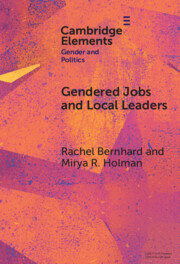268 results
Life in Nature Documentaries: Narrating Counterurbanization and Masculinity in Post-Developmental South Korea
-
- Journal:
- Asia-Pacific Journal / Volume 22 / Issue 9 / September 2024
- Published online by Cambridge University Press:
- 14 March 2025, e1
-
- Article
-
- You have access
- Export citation

Gendered Jobs and Local Leaders
- Women, Work, and the Pipeline to Local Political Office
-
- Published online:
- 07 February 2025
- Print publication:
- 06 March 2025
-
- Element
-
- You have access
- Open access
- HTML
- Export citation
4 - When the Hearth Was at Once Warm and Cold
-
- Book:
- Geographies of Gender
- Published online:
- 09 January 2025
- Print publication:
- 23 January 2025, pp 150-184
-
- Chapter
- Export citation
Chapter 5 - Metropolitan Pleasures and Grievances
-
- Book:
- The Art of Walking in London
- Published online:
- 19 December 2024
- Print publication:
- 23 January 2025, pp 191-234
-
- Chapter
- Export citation
3 - Becoming a Taiwanese Man
-
- Book:
- Geographies of Gender
- Published online:
- 09 January 2025
- Print publication:
- 23 January 2025, pp 115-149
-
- Chapter
- Export citation
Chapter 22 - Masculinity and the Labouring Body
- from Part V - Gender, Sexuality, and the Body
-
-
- Book:
- Gerard Manley Hopkins in Context
- Published online:
- 16 January 2025
- Print publication:
- 16 January 2025, pp 193-201
-
- Chapter
- Export citation
Chapter 21 - Queerness and Homosociality
- from Part V - Gender, Sexuality, and the Body
-
-
- Book:
- Gerard Manley Hopkins in Context
- Published online:
- 16 January 2025
- Print publication:
- 16 January 2025, pp 185-192
-
- Chapter
- Export citation
Indonesian Tourism Workers on Volcanoes and Geotourism's Colonial Origins: Making a Subaltern History Visible
-
- Journal:
- Itinerario / Volume 48 / Issue 3 / December 2024
- Published online by Cambridge University Press:
- 14 January 2025, pp. 268-293
-
- Article
-
- You have access
- Open access
- HTML
- Export citation
Children’s games and global politics: Masculinity, militarism, and the warrior hero
-
- Journal:
- Review of International Studies , First View
- Published online by Cambridge University Press:
- 19 December 2024, pp. 1-18
-
- Article
-
- You have access
- Open access
- HTML
- Export citation
5 - Curb Your Enthusiasm
-
- Book:
- Young and Restless in China
- Published online:
- 02 November 2024
- Print publication:
- 05 December 2024, pp 91-109
-
- Chapter
- Export citation
Chapter 4 - Hunting Churchmen
-
- Book:
- Masculinity in Byzantium, c. 1000–1200
- Published online:
- 07 November 2024
- Print publication:
- 21 November 2024, pp 103-128
-
- Chapter
- Export citation
Conclusions
-
- Book:
- Masculinity in Byzantium, c. 1000–1200
- Published online:
- 07 November 2024
- Print publication:
- 21 November 2024, pp 157-172
-
- Chapter
- Export citation
3 - The Composer as Genius
-
- Book:
- Romantic Music Aesthetics
- Published online:
- 22 November 2024
- Print publication:
- 21 November 2024, pp 75-99
-
- Chapter
- Export citation
Chapter 2 - Ioannes Tzetzes
-
- Book:
- Masculinity in Byzantium, c. 1000–1200
- Published online:
- 07 November 2024
- Print publication:
- 21 November 2024, pp 43-72
-
- Chapter
- Export citation

Masculinity in Byzantium, c. 1000–1200
- Scholars, Clerics and Violence
-
- Published online:
- 07 November 2024
- Print publication:
- 21 November 2024
Chapter 13 - Gender
- from Part II - Social, Cultural, and Intellectual Contexts
-
-
- Book:
- Oliver Goldsmith in Context
- Published online:
- 28 November 2024
- Print publication:
- 07 November 2024, pp 104-113
-
- Chapter
- Export citation
Chapter 20 - Theatre
- from Part III - Literary Contexts
-
-
- Book:
- Oliver Goldsmith in Context
- Published online:
- 28 November 2024
- Print publication:
- 07 November 2024, pp 169-177
-
- Chapter
- Export citation

Young and Restless in China
- Informal Economy, Gender, and the Precariat
-
- Published online:
- 02 November 2024
- Print publication:
- 05 December 2024
“The streaming eyes of all the many men”: Revisiting male weeping in British commemoration of the First World War
-
- Journal:
- Social Science History / Volume 48 / Issue 4 / Winter 2024
- Published online by Cambridge University Press:
- 03 December 2024, pp. 667-685
- Print publication:
- Winter 2024
-
- Article
-
- You have access
- Open access
- HTML
- Export citation
Priests and their Wigs in Eighteenth-Century Rome
-
- Journal:
- Church History , First View
- Published online by Cambridge University Press:
- 16 October 2024, pp. 1-20
-
- Article
-
- You have access
- Open access
- HTML
- Export citation


